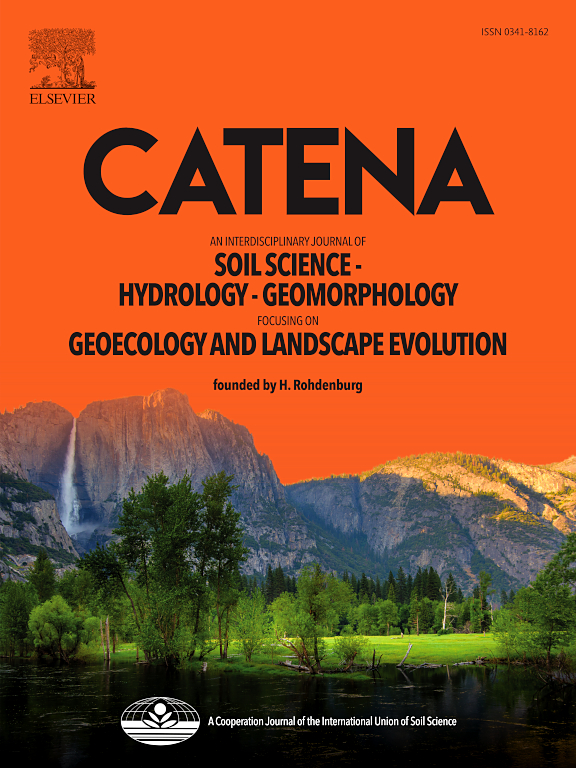The Upper Paleolithic paleolandscapes: A record in the paleosol-sedimentary sequence of the archaeological site Kostenki 17 (Voronezh region, Russia)
IF 5.4
1区 农林科学
Q1 GEOSCIENCES, MULTIDISCIPLINARY
引用次数: 0
Abstract
The Kostenki-Borshevo archaeological complex, located on the right bank of the Don Valley, is the largest cluster of Upper Paleolithic sites in Eastern Europe. Despite extensive research, many paleoecological issues related to these sites remain unresolved, particularly those concerning the history of their surface and pedogenic processes. In this study, we focus on the topography and the colluvial paleosol–sediment sequence at Kostenki 17 (K-17) as one of the most representative sites in terms of landscape record completeness. Our research involved geodetic surveys, drilling, tephra analysis, and a variety of soil-lithological methods, including grain size analysis, loss on ignition (LOI), X-ray fluorescence (XRF), organic carbon content (TOC), and both macro- and micromorphological analyses.
The results of the research made it possible to trace the stages of the recent geological history of the K-17 site and to reconsider some established ideas about the sedimentation and pedogenic processes that formed the deposits containing cultural layers. We have shown that the K-17 site is not part of a river terrace, as was often previously believed, but belongs to a colluvial cover leaning against the base of the bedrock slope of the valley. Convincing evidence was found for the presence of permafrost and solifluction process, which deformed the so-called Upper Humic Bed (UHB, second part of MIS 3), containing cultural layer I. Additionally, we have identified that the formation of the paleosols within the UHB was significantly impacted by humans. The high saturation of wood and bone charcoal, as well as artefacts, point to an anthropogenic influence on soil formation. For the first time, reliable geochemical evidence has been obtained for the source of volcanic ash at the K-17 site. We made the assumption that the site was chosen for settlement by Paleolithic humans based on its geomorphological position.
旧石器时代晚期的古景观:俄罗斯沃罗涅日地区Kostenki 17考古遗址的古土壤-沉积序列记录
Kostenki-Borshevo考古建筑群位于顿河河谷的右岸,是东欧最大的旧石器时代遗址群。尽管进行了广泛的研究,但与这些遗址有关的许多古生态问题仍未得到解决,特别是有关其地表和成土过程的历史问题。在本研究中,我们将Kostenki 17 (K-17)作为景观记录完整性最具代表性的地点之一,重点研究地形和崩塌古土壤-沉积物序列。我们的研究涉及大地测量、钻探、土壤分析和各种土壤岩性方法,包括粒度分析、着火损失(LOI)、x射线荧光(XRF)、有机碳含量(TOC)以及宏观和微观形态分析。研究结果使我们有可能追溯K-17遗址最近地质历史的各个阶段,并重新考虑关于形成含有文化层的沉积物的沉积和成土过程的一些既定观点。我们已经证明,K-17遗址并不像以前经常认为的那样是河流阶地的一部分,而是属于一个靠在山谷基岩斜坡底部的崩塌盖层。发现了令人信服的证据,证明永久冻土和溶蚀过程的存在,使所谓的上腐殖层(UHB, MIS 3的第二部分)变形,其中包含文化层1。此外,我们已经确定UHB内古土壤的形成受到人类的显著影响。木材和骨炭的高饱和度,以及人工制品,表明人类对土壤形成的影响。首次为K-17遗址的火山灰来源获得了可靠的地球化学证据。我们假设旧石器时代的人类根据它的地貌位置选择了这个地方作为定居点。
本文章由计算机程序翻译,如有差异,请以英文原文为准。
求助全文
约1分钟内获得全文
求助全文
来源期刊

Catena
环境科学-地球科学综合
CiteScore
10.50
自引率
9.70%
发文量
816
审稿时长
54 days
期刊介绍:
Catena publishes papers describing original field and laboratory investigations and reviews on geoecology and landscape evolution with emphasis on interdisciplinary aspects of soil science, hydrology and geomorphology. It aims to disseminate new knowledge and foster better understanding of the physical environment, of evolutionary sequences that have resulted in past and current landscapes, and of the natural processes that are likely to determine the fate of our terrestrial environment.
Papers within any one of the above topics are welcome provided they are of sufficiently wide interest and relevance.
 求助内容:
求助内容: 应助结果提醒方式:
应助结果提醒方式:


